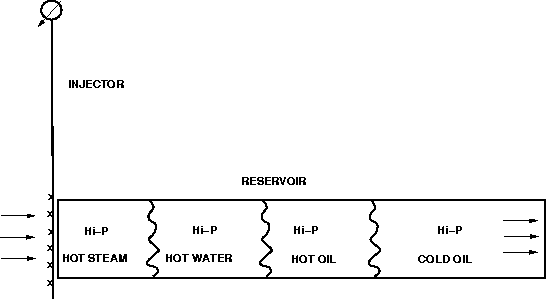




Next: Fluid-flow propagation speeds
Up: RESERVOIR FLUID FLOW
Previous: Steamflood model
This model is slightly more complicated than the conventional block
model of a steam zone, a hot condensate zone, and a cold oil zone,
but does not try to incorporate
the complexity of mixed fluid phases, emulsions, fingering, gravity
overrides, etc., as described by Lake 1989 for example.
As a point of interest, the seismic images show no evidence
of gravity override at the top of the P formation. If a thin steam
zone existed along the formation top, it would show up as a bright
reflection, and possibly cause some time delay below, depending on its
thickness. The reason that gravity override is not visible may be
because the permeability and absence of clay is much higher
at the base of the P formation than at the top. This would
inhibit steam from racing along the top of the formation, and
favor it spreading slowly along the base of the unit instead.
steam-fronts
Figure 9 An idealized model of steamflood fluid flow.
A rapid high-pressure cold front is expected
to lead the injector flow, trailed by hot oil, hot water
and hot steam zones. The relative dimensions of each zone
are not to scale, and complexities such as mixed phases
and gravity overrides are neglected.






Next: Fluid-flow propagation speeds
Up: RESERVOIR FLUID FLOW
Previous: Steamflood model
Stanford Exploration Project
11/12/1997
